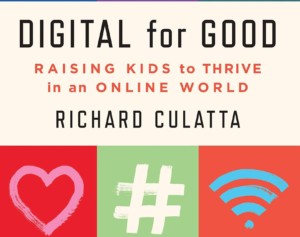Blended Schools & Tools
The key to personalization. Public Impact’s Emily Ayscue Hassel and Bryan Hassel shared their thoughts on the RTTT-D competition on the EducationNext blog: The Original Personalization App—Great Teachers.
Popular penguin performs. The nonprofit MIND Research Institute released an analysis of 2012 Chicago Public Schools (CPS) test results showing that students using ST Math® — a visually based, digital math program featuring the animated penguin named JiJi — made significant gains in math proficiency compared to similar schools. Twenty-three CPS schools that fully implemented the blended learning ST Math program for two years in a row saw an 11.4 percent increase in the number of students who met or exceeded standards on the Illinois Standards Achievement Test (ISAT), while similar CPS schools without ST Math only grew 3.6 points.
1:1 leaders name 1:1 leaders. Project RED has selected 10 districts to become Project RED Signature Districts. Through a competitive application process, these districts were chosen to receive support and guidance for 1:1 education technology implementations. Sponsors include: Intel, HP, Smart Technologies and Pearson Foundation.
Are you the Next EDU Guru? Google, Khan Academy and YouTube announced the launched of Next EDU Gurus the search for emerging online education superstars.
Set that DVR. NBC News announced that the 2012 “Education Nation” National Summit will highlight ten case studies of schools and programs from around the country that have implemented focused solutions in their communities, and have seen demonstrable success – including blended learning model Carpe Diem (one of Getting Smart’s 14 High Schools Worth Visiting). Accompanying each example will be a robust digital toolkit with details on each program’s history, how it works and is funded, and its results. Case studies will be incorporated into the Summit program, as well as featured on-air across NBC News, and available for viewing and download at EducationNation.com beginning Sept .24.
Flipping wildfire. An Ohio school district announced that “flipped math” has “caught on like wildfire.” To make the flipped classroom a reality, Hilliard School’s teachers and school leaders worked with Pearson to implement the online learning tool MathXL and trained 45 teachers from three district schools on the MathXL program.
Digital Developments
The need for speed. The Education Super Highway National School Speed Test is now underway. The group aims to Ensure that every K-12 school in America has 100MB+ of broadband infrastructure, starting with this inventory. Click here to check your school’s speed.
CFY attention. The New York Times published A Digital Tool to Unlock Learning that featured CFY’s work and the free K-12 online platform PowerMyLearning. CFY will also be participating in the live broadcast of American Graduate Day on Sept. 22nd on public television stations across the country.
Learning about Learning Badges. The MacArthur Foundation’s Digital Media and Learning initiative has granted $400,000 to an associate professor in the Indiana University School of Education’s Learning Sciences program to study digital badges. Through the two-year Digital Badges Design Principles Documentation project, Dan Hickey and his doctoral students will document the design principles that emerge across the 30 awardees in the “Badges for Lifelong Learning” competition funded by MacArthur and Gates foundations.
Innovation Nation? This year’s Education Nation’s Innovation Challenge participants have been announced and include three NoRedInk, Pathbrite, and ReadImagine. Edmodo’s COO Crystal Hutter has been named as a mentor for the competition and will provide counsel and support to each of the teams competing for this year’s $100,000 grand prize.
Advisors to the President. The Council for Economics Education (CEE) is holding a video contest asking students in kindergarten through 12th grade, via their teachers, for the best economic advice they can give our new President. Teachers should record one student, or a group of students, answering the question “What Should the Next President do to Improve the Economy?” Enter your video today!
Free next week? PLATO Learning, Archipelago Learning, and EdOptions software-as-a-service (SaaS) providers of education solutions announced the 2012EdTech Customer Conference that will take place September 23-24 in Columbus, Ohio. EdT will focus on several key trend issues currently affecting education such as Common Core Standards, RTI, virtual programs, personalized learning, and the flipped classroom. The conference’s keynote presentation will be conducted by Innosight Institute’s Michael B. Horn. Register online at http://www.plato.com/edtech.
Steamy STEM Gems
Checking vital signs. A new set of reports from Change the Equation (CTEq) paints a wide-ranging and in-depth picture of science, technology, engineering, and mathematics (STEM) learning in each state and the District of Columbia. Vital Signs 2012 examines not only student performance but also access to educational opportunity and the amount of instructional support schools and teachers receive. The 51 state reports, which include data never available before, offer specific recommendations for each state to improve STEM teaching and learning in grades K-12.
Mark your calendar. 2012 California STEM Summit will be taking place October 15 and 16 at the Sheraton in San Diego, where the California STEM Learning Network (CSLNet) is convening business, government, education, nonprofit and philanthropic luminaries to jump-start new STEM education initiatives.
STEM Station. NASA’s Digital Learning Network is offering a unique opportunity to see firsthand how operating the International Space Station is tied to STEM classroom lessons, with the launch of its new module: “STEM On Station.”
Big stuff on little science. NanoProfessor announced today that its textbook, “Introduction to Nanoscale Science and Technology,” is now available for purchase on Amazon.com. The textbook has been written specifically for the undergraduate student and is a valuable resource for anyone seeking a greater understanding of nanotechnology, which is helping create innovations in the areas of physics, chemistry, materials science, biology, medicine, and engineering. Read more about NanoProfessor in Sarah’s piece from earlier this month.
Getting to the Core
Smarter Conference. Last week, the Smarter Balanced Assessment Consortium held its second semi-annual Collaboration Conference about the design and implementation of an assessment system that is aligned with the Common Core State Standards in math and English literacy. The conference, which involved K-12 state leaders, higher education leaders, work groups, and contractors from the consortium’s 21 governing states, included a two-hour public meeting to discuss the development of achievement level descriptors (ALDs), a sampling plan for the pilot test, and an approach to sustainability planning, as well as other issues.
Common Core Readiness. EdWeek reported on a report by Achieve, noting that the 7th annual “Closing the Expectations Gap” report indicates, “nearly all states are developing instructional materials to help districts and schools implement the Common Core State Standards” with 39 states indicated that they have developed a plan for professional development aligned to the CCSS.
Quick Guides. Kathy Kellman, Executive Editor of Mathematics at Curriculum Associates offered Quick Guide to the Common Core: Key Common Core Expectations Explained – Mathematics as the second part of a series that began last week with vice president of product development at Curriculum Associates Adam Berkin’s Quick Guide to the Common Core: Key Common Core Expectations Explained for the English Language Arts standards.
Come On Get App-y
ESL App. Archipelago Learning has introduced Newcomers’ Storybooks and a Speaking Component to ESL ReadingSmart. The ESL ReadingSmart Newcomers’ Storybooks will help students engage with the English language by allowing them to read and interact with literature.
Higher Ed Helpers. Apps for college students are popping up left and right. U.S. News & World Report supplied 5 iPhone Apps to Use for Networking in College, while The University Network announced the release of “Deal Finder,” a free mobile app that helps students save money locally. Deal Finder is available for Android and iPhone., and helps students find nearby deals everyday on the goods and services they regularly spend money on, including food, entertainment, nightlife, beauty, fitness and even doctor visits.
App partners. YogiPlay, a new personalized recommendation service that empowers parents to quickly find the best learning apps for their kids, announced a new partnership with educational apps discovery destination, Teachers With Apps (TWA).
Higher, Deeper, Further, Faster Learning
Grants for the future. Jobs for the Future (JFF) announced that five states—Illinois, Kansas, Kentucky, Louisiana and North Carolina—will each receive a $1.6 million grant to help more workers earn valuable credentials needed for today’s good jobs through innovative adult education programs. The grants are part of Accelerating Opportunity: A Breaking Through Initiative, an $18.5 million strategic collaboration of diverse philanthropies including the Bill & Melinda Gates Foundation, the Joyce Foundation, the W.K. Kellogg Foundation, the Kresge Foundation, the Open Society Foundations, and the University of Phoenix Foundation.
“Teach less, learn more.” Reviewing recent reports, Mindshift asked this week: How Do We Define and Measure “Deeper Learning”? The article quotes Linda Darling-Hammond who speaks the shifts in teaching and in assessing students that will be necessary to contribute to deeper learning.
If you build it, they will come. The Saylor Foundation announced a collaboration with Google to offer courses through the Course Builder open source project. Saylor’s Mechanics I will be open for free registration and will be immediately available to individuals across the globe via the beta platform released by Google. Based on the software used by Google to build Power Searching with Google, the Course Builder open source project is an experimental technology and is the first step toward helping educational organizations scale their offerings through the cloud.
Join the revolution. The higher education revolution continues to get increasing attention, as evidenced by Duke’s piece this week: MOOCs: What role do they have in higher education?
Beyond digital textbooks. The Atlantic featured Ginkgo Tree, a tool that allows professors to create digital “coursepacks” by uploading links and images, embedding video, posting comments, and importing scanned pages from print books. All of those resources get bundled into modules and arrayed in a navigable grid. |






0 Comments
Leave a Comment
Your email address will not be published. All fields are required.